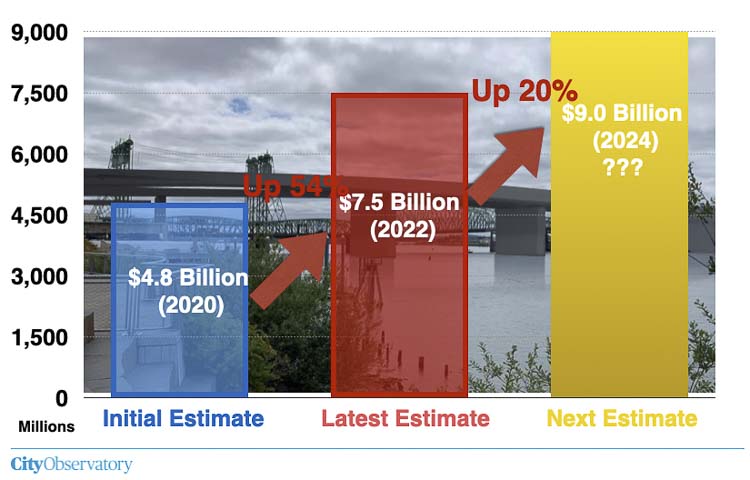Joe Cortright of the City Observatory addresses the rising cost of the Interstate 5 Bridge replacement project
Joe Cortright
City Observatory
The cost of the Interstate Bridge replacement is going up: but Interstate Bridge Replacement Program (IBR) officials won’t tell you how much … and they’re not going to tell you until a year from now, after the 2025 Legislature adjourns.

In January 2024, IBR officials publicly acknowledged that their 13-month-old cost estimate of up to $7.5 billion was wrong, and promised a new estimate “later this summer.”
It’s now summer, and IBR officials are now saying their new estimate won’t be done for another year “about this time next year” (June 2025).
IBR officials are keeping secret the new higher cost until after the Oregon and Washington legislatures meet. ODOT has specifically excluded any mention of additional funding for the IBR project from its presentations to legislative committees contemplating a new finance plan for ODOT for the 2025 session.
ODOT is touting a newly announced $1.5 billion federal grant for the project. But the project’s price tag is rising faster than it is finding money to pay for the bridge. And Oregon and Washington will be holding the bag for any cost increases or toll revenues shortfalls.
A delayed project is hiding a higher price tag
As we’ve pointed out, the project is two years behind the schedule announced when it was re-started in 2020, and is falling further behind. The cost of the project has ballooned from a maximum of $4.8 billion in 2020, to as much as $7.5 billion in 2022. Earlier this year, IBR officials revealed the price tag would be even higher, and promised to reveal a new estimate in the summer of 2024. But now, this plainly isn’t going to happen.
At a June 13 Community Advisory Committee meeting, IBR Administrator Greg Johnson conceded the IBR’s budget was going up again, but that it would now be summer of 2025 before they would reveal the actual price tag. It will probably be around this time next year that we will have that final process completed with a more rigorous and up to date number for overall construction costs.
A chronology of cost estimates
No one should place much credence on IBR cost estimates: they always go up.
• November 2020 Initial cost estimate $3.3 to $4.8 billion
• May 2022: City Observatory predicts costs will rise to $5-$7 billion. As Willamette Week reported, our City Observatory prediction — made in May, 2022, seven months before the IBR estimates were released — that the cost of the IBR would balloon to between $5 to $7 billion was spot on, and slightly conservative.
• December 2022, new cost estimate $5 to $7.5 billion. And in December 2022, IBR officials confidently assured alarmed legislators that they would prevent future cost increases thanks to WSDOT’s “CEVP” process designed to manage risks. City Observatory filed a public records request for that CEVP, and in January 2023, IBR officials claimed that “no records exist” of any CEVP work.
• January, 2024: IBR Director Greg Johnson says “costs are going up. We are going to be reissuing an overall program estimate probably later this summer.”
• June 2024: IBR testifies it will do another cost estimate “about this time next year”. Greg Johnson, in comments to the IBR’s community advisory group.
“It was our plan to go into another what’s called a CEVP cost validation, estimating process that looks at risk and evaluates and puts a cost to risk. And so the last time we did this, which was two years ago, we came up with the range between five and seven and a half billion. And that seven and a half billion was the worst case scenario at that time. But once again, as we have seen, the outpacing of inflation rates beyond what anybody was expecting in the construction industry, those numbers are going higher. We are seeing it across the nation on large construction projects, so we expect that number to be higher. We were going to start another CEVP process on the heels of getting the draft supplemental document done. But now, as that has been pushed, we are pushing that CEVP to understand what we are building. So we will probably it will probably be around this time next year that we will have that final process completed with a more rigorous and up to date number for overall construction costs.’’ – IBR Administrator Greg Johnson
June 2025: Next cost estimate: Likely $9 billion or more

Lying and concealing cost increases
The IBR is the single largest highway project in Oregon history, and will severely tax the managerial and financial capabilities of the Oregon Department of Transportation. Even as Gov. Tina Kotek says ODOT faces “catastrophic funding challenges” the need for additional funding for the IBR project is also consistently omitted from ODOT’s lengthy financial presentation. The Oregon Department of Transportation has been participating in hearings around the state on its financial condition, and its presentations never make any mention of the state’s liability for these cost increases for the bridge replacement project. By postponing the next cost estimate until the summer of 2025, ODOT is concealing this information from the Legislature as it debates a major transportation measure.
This process is a classic example of what Bengt Flyvbjerg diplomatically calls “strategic misrepresentation” — what we would more colloquially call lying: in this case, low-balling the cost estimate to get the project started and get an initial commitment of funds, and then jacking up the price tag when it’s “too late” to consider anything different.
And the agency has essentially no process for managing or preventing cost increases. The price of the I-205 Abernethy Bridge has tripled to $750 million; the price of the I-5 Rose Quarter project has quadrupled to $1.9 billion. And the financial tools that ODOT says it uses to control costs, grandly called the “Cost Estimate Validation Process” (CEVP) do nothing.
As we’ve pointed out before, the CEVP doesn’t so much manage or prevent risks as document how devastating they are when they occur. In the case of the Columbia River Crossing, the CEVP process failed completely to identify the cost and schedule risk of the Coast Guard’s decision not to agree to a 95-foot navigation clearance, which added more than a year and tens of millions of dollars to the project’s cost. In the case of the current project, just this year, the CEVP process grossly underestimated the likelihood and schedule risk of IBR’s flawed and outdated traffic models, which were thought to add no more than a six month but are now understood to delay the project by as much as 18 months.
Also read:
- Opinion: Neighbors for a Better Crossing calls for a current seismic study for $7.5 Billion Interstate Bridge projectNeighbors for a Better Crossing is urging a new seismic study before construction proceeds on the $7.5 billion IBR project, raising transparency concerns and proposing an immersed tube tunnel alternative.
- Rep. John Ley supports C-TRAN Bus Rapid Transit to save Washington moneyRep. John Ley praised C-TRAN’s new BRT line as a faster, lower-cost alternative to light rail, urging support for transit options that save taxpayers money and improve service.
- C-TRAN, WSU Vancouver celebrates groundbreaking for The Vine on Highway 99C-TRAN and WSU Vancouver broke ground on the Vine’s Highway 99 route, a 9-mile bus rapid transit line connecting the university to downtown Vancouver and the Waterfront, set to open in 2027.
- C-TRAN board again postpones vote on light rail operations and maintenance costsThe C-TRAN board again postponed a vote on language regarding operations and maintenance costs tied to light rail expansion, with pending lawsuits involving Michelle Belkot continuing to impact board actions.
- Opinion: ‘The Interstate Bridge project lacks billions in funding from both Oregon and Washington’Lars Larson criticizes Oregon’s funding decisions, highlighting the billions missing from both states for the Interstate Bridge replacement project and calling it a dead-end effort lacking Coast Guard approval.










Thank you, Joe Cortright, for this timely and important compilation of relevant details on the Interstate Bridge Replacement Program.
It’s maddening that they can lie, tell half-truths, and continue to rake in over $2 billion in federal tax dollars. What a sad waste of the people’s money.
What is happening that allows any out of control costs? There has to be a budget and stay to that. How can you begin charging tolls when you won’t even have the Coast Guard support, and why not design it tall enough to make it work? No tolls, is what the people want. All this work and your plans don’t work. Get more creative, there are better solutions!